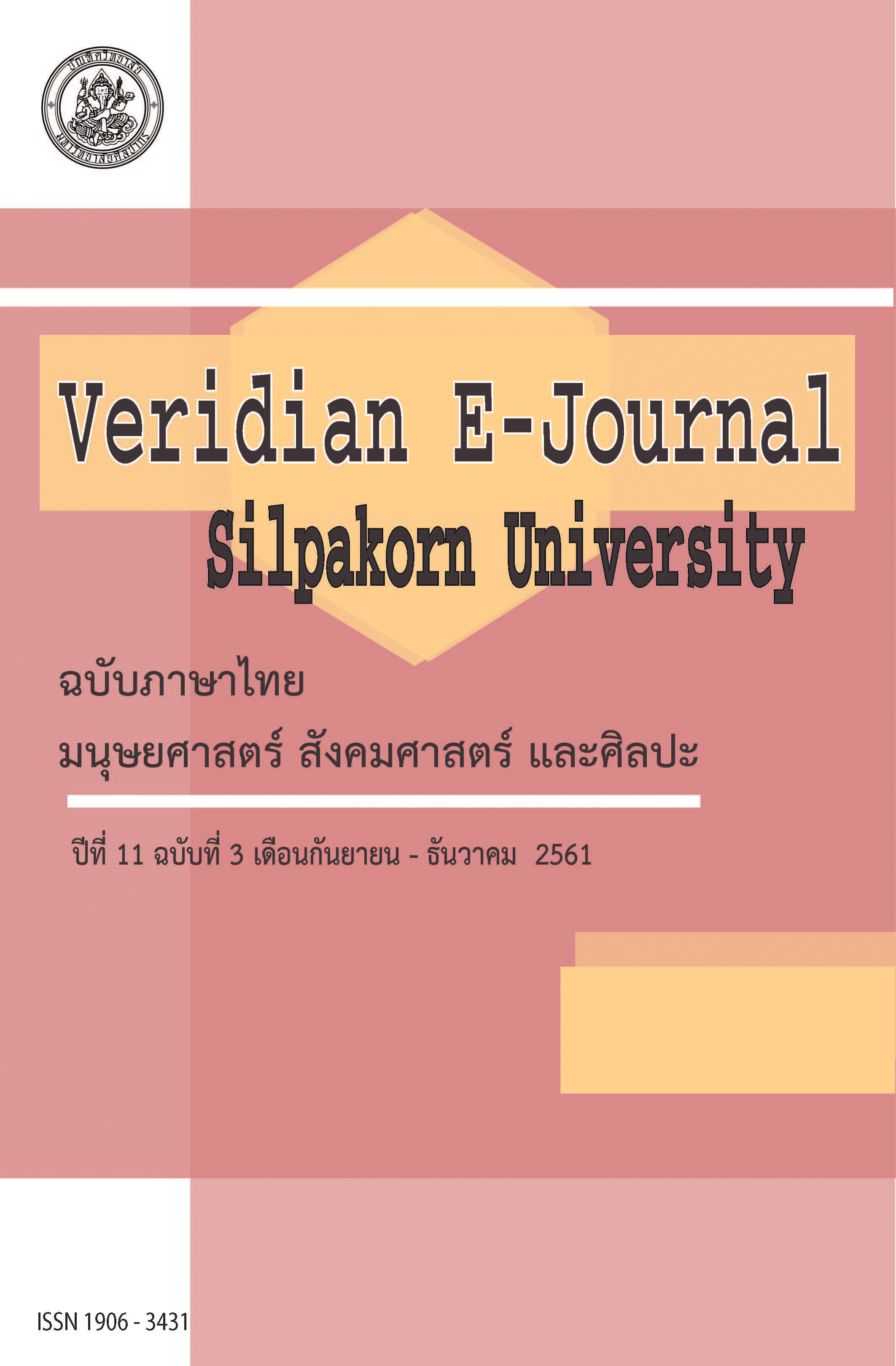การวิเคราะห์ข้อผิดพลาดในการใช้ไวยากรณ์ภาษาอังกฤษในการเขียนอีเมล์ธุรกิจของนักศึกษาคณะนิเทศศาสตร์ มหาวิทยาลัยศิลปากร (An Investigation of Grammatical Errors in Business Email Writing of Undergraduate Communication Arts Students, Silpakorn University)
Main Article Content
Abstract
การวิจัยเรื่อง การวิเคราะห์ข้อผิดพลาดในการใช้ไวยากรณ์ภาษาอังกฤษในการเขียนอีเมล์ธุรกิจของนักศึกษาคณะนิเทศศาสตร์ มหาวิทยาลัยศิลปากร มีวัตถุประสงค์ดังนี้ 1. เพื่อศึกษาระบุและจำแนกข้อผิดพลาดด้านไวยากรณ์ภาษาอังกฤษในการเขียนอีเมล์ธุรกิจของผู้เรียน 2. เพื่อศึกษาความแตกต่างในส่วนของข้อผิดพลาดด้านไวยากรณ์ของนักศึกษาในแต่ละเอกซึ่งประกอบไปด้วยเอกโฆษณา เอกทีวีวิทยุ เอกภาพยนตร์ เอกวารสารศาสตร์ และเอกลูกค้าสัมพันธ์ 3. เพื่อระบุสาเหตุของข้อผิดพลาดและเสนอแนะแนวทางแก้ไข
กลุ่มประชากรที่ทำแบบทดสอบคือนักศึกษาปี 3 คณะเทคโนโลยีสารสนเทศและการสื่อสารสาขาวิชานิเทศศาสตร์ มหาวิทยาลัยศิลปากรประกอบไปด้วยนักศึกษาเอกโฆษณา ทีวีวิทยุ ภาพยนตร์ วารสารศาสตร์และลูกค้าสัมพันธ์ รวมทั้งสิ้น 118 คน โดยผู้ทำแบบทดสอบแต่ละคนจะได้รับโจทย์ตามเอกที่ตนเองศึกษาคนละ 1 ชุดโดยต้องเขียนจดหมายอีเมล์ธุรกิจ โดยการวิเคราะห์มุ่งเน้นไปที่ความถูกต้องด้านไวยากรณ์เป็นหลักรวมถึงองค์ประกอบที่เกี่ยวข้องเช่น คำศัพท์ เครื่องหมายวรรคตอน การสะกดคำ
ผลการวิจัยแสดงให้เห็นว่ากลุ่มตัวอย่างมีข้อผิดพลาดในการใช้ไวยากรณ์ 25 ชนิด ซึ่งสามารถเรียงลำดับความถี่ของข้อผิดพลาดจากมากไปหาน้อยจำนวน 10 อันดับ ดังต่อไปนี้ 1) การใช้อักษรขึ้นต้นตัวพิมพ์ใหญ่ 2) การใช้บุพบท 3) การเลือกใช้คำศัพท์ไม่ถูกต้อง 4) การสะกดคำผิด 5) การใช้กริยาผิดรูป 6) การใช้คำนำหน้าคำนาม 7) การใช้คำนาม 8) การเลือกใช้คำผิดประเภท 9) โครงสร้างประโยคและ 10) การใช้ประธานและกริยาไม่สอดคล้องกัน ในส่วนของความแตกต่างด้านความรู้ด้านไวยากรณ์ของนักศึกษาแต่ละเอก พบว่า มีข้อผิดพลาดในการใช้ไวยากรณ์ไม่แตกต่างกัน
สาเหตุหลักของข้อผิดพลาดในการใช้ไวยากรณ์ภาษาอังกฤษมาจากการแทรกแซงจากภาษาที่หนึ่งและการใช้กฎไวยากรณ์ไม่ถูกต้อง แนวทางในการแก้ไขข้อผิดพลาดดังกล่าวสามารถแก้ไขได้โดยนำข้อผิดพลาดมา เป็นส่วนประกอบในการจัดการเรียนการสอน รวมถึงอธิบายความแตกต่างระหว่างกฎไวยากรณ์ภาษาที่ 1 และภาษาที่ 2 เพื่อให้ผู้เรียนตระหนักถึงความแตกต่างเมื่อนำมาใช้ในการเขียนในลักษณะต่างๆ นอกจากนี้การให้ผู้เรียนมีส่วนร่วมในกระบวนการเรียนรู้และแก้ไขข้อผิดพลาดของตนเองจะช่วยพัฒนาทักษะการเขียนของผู้เรียนได้อย่างมีประสิทธิภาพมากยิ่งขึ้น
The present study ‘An Investigation of Grammatical Errors in Business Email Writing of Undergraduate Communication Arts Students, Silpakorn University’ has the following objectives: 1) to identify the frequency of grammatical errors occurring in writing emails of third year students majoring in Advertising, TV/Radio, Film, Journalism and Customer Relation Management 2) to identify the differences among five majors in terms of grammatical errors, and 3) to identify the sources of these errors.
The sample of the study was third year students who enrolled in English for Communication Arts III in the Faculty of Information and Communication Technology at Silpakorn University during the first semester of 2017, consisting of 118 students from Communication Arts track with five different majors namely Advertising, TV/Radio, Film, Journalism, and Customer Relation Management (CRM). The data was collected using business email tests on five different topics based on students’ majors, focusing on grammatical errors including vocabulary, punctuation and spelling.
The results of the research were prioritizing as follows: The ten most frequent errors from twenty-five types of errors were: 1) capitalization, 2) prepositions, 3) wrong choice of words, 4) misspelling, 5) verb forms, 6) articles, 7) nouns, 8) wrong part of speech, 9) sentence structures, and 10) subject-verb agreements. In terms of the differences regarding grammatical errors among five majors, it was found that there are no significant differences.
The causes of errors were identified as L1 interference and incomplete application of the rules. It is, therefore, suggested that teachers can include each type of errors in the lessons using explicit instructions, elaborating the grammatical differences between L1 and L2 in a variety of contexts in order to provide sufficient and extensive platforms for students to practice their writing skills. Finally, involving students in the process of analyzing their own errors will enable them to enhance and master their writing skills more effectively.
